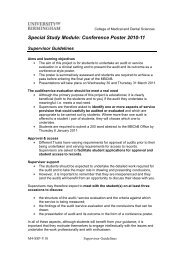Contents - College of Medical and Dental Sciences - University of ...
Contents - College of Medical and Dental Sciences - University of ...
Contents - College of Medical and Dental Sciences - University of ...
Create successful ePaper yourself
Turn your PDF publications into a flip-book with our unique Google optimized e-Paper software.
The 11 th International Workshop on KSHV & Related Agents, Birmingham, UK<br />
Immunology I Abstract 11<br />
UPREGULATION OF THE TLR3 PATHWAY BY KSHV DURING PRIMARY INFECTION<br />
OF MONOCYTES<br />
John West, Sean Gregory <strong>and</strong> Blossom Damania<br />
Department <strong>of</strong> Microbiology <strong>and</strong> Immunology <strong>and</strong> Lineberger Cancer Center, <strong>University</strong> <strong>of</strong><br />
North Carolina at Chapel Hill, North Carolina 27599<br />
Abstract<br />
Kaposi’s sarcoma-associated herpesvirus (KSHV) is associated with several different<br />
human malignancies including Kaposi’s sarcoma, primary effusion lymphoma, <strong>and</strong><br />
multicentric Castleman’s disease. KSHV establishes lifelong latency in the host <strong>and</strong><br />
modulates the host immune response. Innate immunity is critical for controlling de novo<br />
viral infection. Toll like receptors (TLRs) are key components <strong>of</strong> the innate immune<br />
system <strong>and</strong> they serve as pathogen recognition receptors that stimulate the host antiviral<br />
response. In particular, TLR3 has been implicated in RNA virus recognition.<br />
Currently there is no information on how KSHV infection modulates any TLR pathway. We<br />
report the first evidence showing that KSHV upregulates TLR3 expression in human<br />
monocytes sixteen hours post-infection. This is also the first demonstration <strong>of</strong> a human<br />
DNA tumor virus upregulating TLR3, a TLR that thus far has been associated with the<br />
recognition <strong>of</strong> RNA viruses. We found that KSHV upregulates the TLR3 pathway <strong>and</strong><br />
induces TLR3-specific cytokines <strong>and</strong> chemokines, including IFN-β1 <strong>and</strong> CXCL10 (IP-10).<br />
SiRNAs directed against TLR3 greatly reduced the ability <strong>of</strong> KSHV to upregulate IFN-β1<br />
<strong>and</strong> CXCL10 upon infection. TLR3 upregulation was monitored at different time-points<br />
post-infection. We found that TLR3 expression levels were highest 16 hours postinfection<br />
<strong>and</strong> slowly declined thereafter returning to baseline by 120 hours post-infection<br />
as the virus established latency.<br />
Presenting author Email: john_west@med.unc.edu<br />
32















